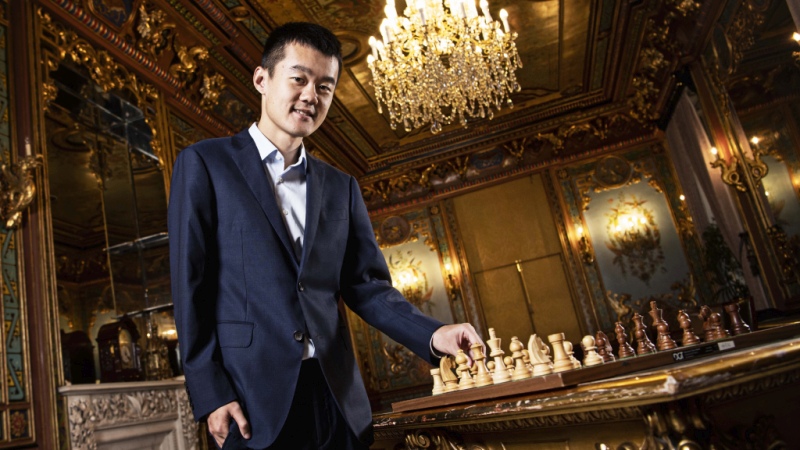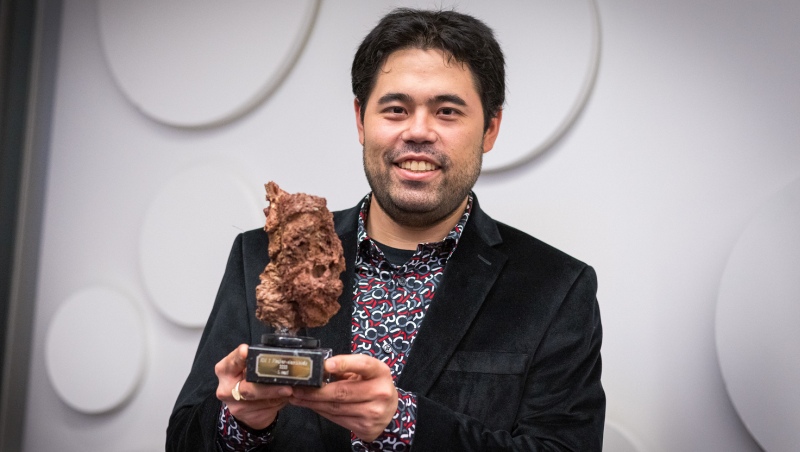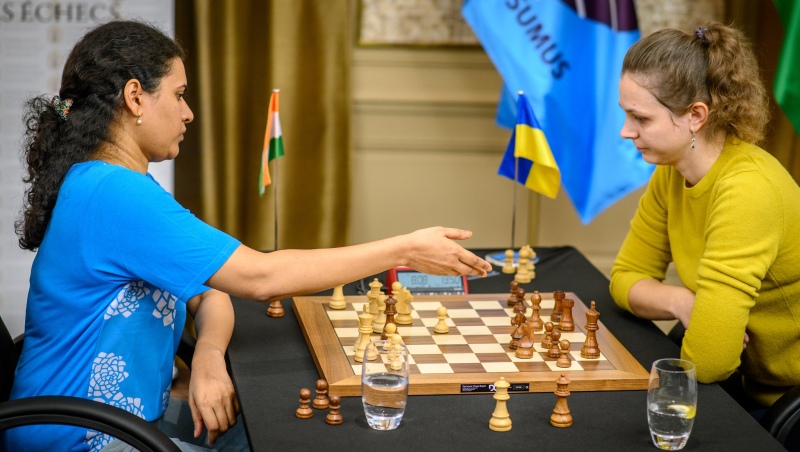Ding Liren gets official invitation to take part in FIDE World Championship match 2023

Grandmaster Ding Liren received this weekend the official invitation to take part in the FIDE World Championship match 2023, after the current World Champion Magnus Carlsen formally confirmed, in writing, that he gives up his right to take part in the match and defend his title. FIDE is currently negotiating with two potential hosting cities for the World Championship 2022. Once one of these proposals is approved, and the location, prize fund, and exact dates are fixed, Ian Nepomniachtchi and Ding Liren will receive the contract for the match.
New US World Champion – Nakamura follows in Bobby Fischer’s footsteps

US Chess Grandmaster Hikaru Nakamura gained his first world title, winning the FIDE World Fischer Random Chess Championship today in Reykjavik, Iceland. He defeated Ian Nepomniachtchi, the previous and current challenger for the classical chess world title, winning in a nail-biting “Armageddon” playoff game after their match ended 2-2. The event was hosted by Iceland to commemorate the legendary chess match in Reykjavik where Bobby Fischer wrested the world champion title from Boris Spassky. The 1972 match was viewed as a Cold War battle between the turbulent American loner Fischer, and the traditionally dominant chess power of the Soviet Union. Ready for battle A very Fischer Random kind of daily routine has settled over the players, reflecting both the game and the format of the event. Magnus Carlsen’s towering second, Danish Grandmaster Peter Heine Nielsen, is always the first to arrive for the security check and unveiling of the start position. Carlsen will almost always appear last, breathless and bushy-haired. The organizers check their watches as the field and assistants gradually turn up, wondering if there is any gamesmanship in trying to be as close to late as possible. Unlike a traditional chess event, where opening preparation is laborious and top-secret, here, the players regularly kill down time by discussing previous games and wondering about the subtleties of play from as early as the first move. The philosophical discussions between professed Fischer Random lover Vladimir Fedoseev and Heine Nielsen would likely never take place in a classical chess setting and never before a serious game. Here, the fresh appeal of unexplored random territory has swept aside such obstacles. First battlefield Start position for mini-match one The final day’s matches will be best-of-four and decide each pair of final standings. Hikaru Nakamura chooses a pawn from Chief Arbiter Omar Salama’s outstretched fists and will play with the black pieces in games 1 and 4. His choice also determines the color sequence in all matches, with all higher-rated players – according to FIDE’s September 2022 Rapid Chess rating list – following his pattern. The pairings will therefore start: World Championship Title Final: Ian Nepomniachtchi – Hikaru Nakamura 3-4 play-off: Nodirbek Abdusattorov – Magnus Carlsen 5-6 playoff: Vladimir Fedoseev – Wesley So 7-8 play-off: Hjorvar Steinn Gretarsson – Matthias Blübaum Carlsen tells Norwegian TV that the start position looks ‘fairly normal’, except for the odd corners. Icelandic Grandmaster Helgi Olafsson, here as Hjorvar Steinn Gretarsson’s assistant, has a more concrete reaction: “The b-pawn will be popular!” referring to the initial move that liberates the most pieces. After this, the players scramble to their preparation area, to try and work out some basic ideas for both sides of the position. Artistic echo The first move of the final session is made by noted Norwegian photographer Dag Alveng, who has a historical link to the event. The unofficial title match between Nakamura and Carlsen to revive Fischer Random was held in Norway in 2018, with an Alveng exhibition of photos as the backdrop for the event, held at the Henie Onstad Art Center. When play began, the games reflected both verbal predictions – the b-pawn was indeed popular, and the games were more sedate and ‘classical’ than the random violence that has often appeared earlier in the event. The title match was the first to come to the boil, with both of the candidates fond of aggression and risk. Title duel Nakamura’s long experience with Fischer Random appears to give him greater flexibility: he seems to have a fine sense of acceptable risk, even in the often bizarre settings the opening position can provide. Nepomniachtchi played uncharacteristically slowly and was soon embroiled in dangerous complications, which Nakamura handled much better. After the game, Nakamura said: “Obviously, it’s nice to win in the first game, but more than that, it was good to just play a simple position, most of the (start) positions we’ve been getting have been pretty difficult… Overall it felt very smooth.” Nepomniachtchi visibly chose to chase the second game, breaking with a mirrored scheme of development to launch an attack that counted on confusion to make up for objective correctness. Nakamura navigated the complications well, and chose to repeat the position and split the point even though he could have tried for more by risking more adventures in the firing line. Preserving his lead took top priority. Bronze drama The course of the first Abdusattorov – Carlsen game was nothing short of baffling. The Norwegian classical world champion was producing a patented technical grind, steadily increasing a positional advantage and having a big edge on the clock, with Abdusattorov’s time running down to zero. Then, in quick succession, Carlsen missed a probably winning blow, walked his king into tactical danger, and finally shed all of his remaining pieces to complete a remarkable fourth, wobbly loss in a row. After resigning, Carlsen tried to reset the pieces on the board, looked confused – since the start position here isn’t so easy to remember – then just shook his head with a sad grin on his face and left the playing room. Abdusattorov told Norwegian TV that Carlsen is clearly not in good shape here, but … there were three games still to play. The return fixture ended in revenge for the Norwegian, but only after a nervy back-and-forth struggle where both players were given chances to get the upper hand. So – Fedoseev This heavyweight battle had the air of very safe and solid games from position one, with balanced material, calm manoeuvring and gradual simplification – result: two evenly fought and solid draws. Blübaum – Gretarsson Blübaum took the lead after his Icelandic opponent blundered badly in what had been a fairly balanced game. The return game was a very solid affair, which ended in a draw, despite prolonged efforts. The final battlefield? Starting position two By now, there was no surprise when heads began to shake as the pieces landed on the demo screen. “Every time you have a knight in the
Anna Muzychuk edges out Humpy Koneru to reach semifinal

Anna Muzychuk narrowly defeated Humpy Koneru on a tiebreaker and advanced into the semifinals of FIDE Women’s Candidates. Four rapid games with the time control of 15+10 plus two blitz 5+3 blitz games in case of an equal score were scheduled between two opponents on October 30. If the score was still equal, then a certain number of 3+2 games would have been played until there was a winner. The first rapid game was a pretty solid one, as there were no big swings of evaluation by chess engines. It was the same Petrov Defence as in their classical games, with Anna playing 3.d4. This time around, Humpy deviated on the move 5, exchanging the knights with 5…Nxd2. Humpy had an advantage on the clock and some pressure on White’s position, but it was not enough – the game ended in repetition on the move 32. The second rapid game was also of very good quality as no player made obvious mistakes. Humpy deviated first from the game they played in the classical portion of the match with 6.Qa4+. After the queens exchange a few moves later, the opponents ended up in a balanced position and shook hands on move 34. Things started to get messy in the third rapid game, where this time Anna tried a new move 10.Bf5, in the line of Petrov Defence from the first rapid encounter. It seems like Humpy’s 13…Bxf5 was not the best decision, and Anna got a superior position thanks to the open g-file. White quickly took control of the proceedings, but it was still a very complicated position. Apparently, Muzychuk missed with 21…Bxc3! that gave Black dangerous counterplay. Anna’s reaction was far from optimal, and Humpy grabbed the initiative but not for long. A couple of mistakes from Koneru followed, and the pendulum swung again – Anna got an overwhelming advantage, but, short of time, she did not find a study-like win. Indeed after 30.Nd2!! sacrificing the knight but disrupting the coordination of Black’s pieces, White was winning. The main line is 30…Bxd2 31.Rg1 Bg5 32.h4 Bd8 33.f6 and Black has no way out. Instead, 30.Rg1 was played straight away, which allowed Humpy to force a draw by perpetual 30…Rb2+ 31.Kc1 Nd3+ 32.Kd1 Nxf2+ 33.Kc1 Nd3+ ½-½ This tiebreak had a very dramatic finale in a situation when both players were under tremendous pressure. Playing with Black, Anna made a very interesting opening choice, sacrificing a pawn for the initiative. The game ended prematurely though, as Humpy blundered a piece: Black just played 16.Bd2?? and resigned after 16…Bxd4 17.exd4 Qxe2 0-1 The match was extremely tense, with both players showing some amazing chess. One could be disappointed by a blunder that ruins five days of hard for five days, but competitive chess is cruel sometimes. Congratulations to Anna Muzychuk, who advances to the semis, where she faces Lei Tingjie. Right after the tiebreaker, a quick drawing of lots was held. Anna Myzuchuk will have white pieces in the first game of the semifinal. October 31 will be a rest day, a well-deserved time for the players to recover from their tough matches. The semifinal will start on October 1 at 15:00 CET. Official webstie: womenscandidates.fide.com Text: WGM Andreea Navrotescu Photo: Michał Walusza ORGANIZERS: PARTNERS:

